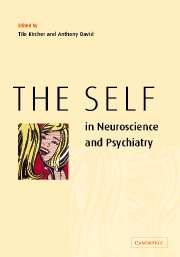Book contents
- Frontmatter
- Contents
- List of contributors
- Introduction: the self and neuroscience
- Part I Conceptual background
- Part II Cognitive and neurosciences
- 5 The multiplicity of consciousness and the emergence of the self
- 6 Asynchrony, implicational meaning and the experience of self in schizophrenia
- 7 Self-awareness, social intelligence and schizophrenia
- 8 The neural correlates of self-awareness and self-recognition
- 9 Autonoetic consciousness
- 10 The neural nature of the core SELF: implications for understanding schizophrenia
- Part III Disturbances of the self: the case of schizophrenia
- 11 Self and schizophrenia: a phenomenological perspective
- 12 Self-disturbance in schizophrenia: hyperreflexivity and diminished self-affection
- 13 The self-experience of schizophrenics
- 14 The paranoid self
- 15 Schizophrenia and the narrative self
- 16 Self-narrative in schizophrenia
- 17 Schizophrenia as disturbance of the self-construct
- 18 Action recognition in normal and schizophrenic subjects
- 19 Disorders of self-monitoring and the symptoms of schizophrenia
- 20 Hearing voices or hearing the self in disguise? Revealing the neural correlates of auditory hallucinations in schizophrenia
- 21 The cognitive neuroscience of agency in schizophrenia
- 22 Self-consciousness: an integrative approach from philosophy, psychopathology and the neurosciences
- References
14 - The paranoid self
from Part III - Disturbances of the self: the case of schizophrenia
Published online by Cambridge University Press: 18 December 2009
- Frontmatter
- Contents
- List of contributors
- Introduction: the self and neuroscience
- Part I Conceptual background
- Part II Cognitive and neurosciences
- 5 The multiplicity of consciousness and the emergence of the self
- 6 Asynchrony, implicational meaning and the experience of self in schizophrenia
- 7 Self-awareness, social intelligence and schizophrenia
- 8 The neural correlates of self-awareness and self-recognition
- 9 Autonoetic consciousness
- 10 The neural nature of the core SELF: implications for understanding schizophrenia
- Part III Disturbances of the self: the case of schizophrenia
- 11 Self and schizophrenia: a phenomenological perspective
- 12 Self-disturbance in schizophrenia: hyperreflexivity and diminished self-affection
- 13 The self-experience of schizophrenics
- 14 The paranoid self
- 15 Schizophrenia and the narrative self
- 16 Self-narrative in schizophrenia
- 17 Schizophrenia as disturbance of the self-construct
- 18 Action recognition in normal and schizophrenic subjects
- 19 Disorders of self-monitoring and the symptoms of schizophrenia
- 20 Hearing voices or hearing the self in disguise? Revealing the neural correlates of auditory hallucinations in schizophrenia
- 21 The cognitive neuroscience of agency in schizophrenia
- 22 Self-consciousness: an integrative approach from philosophy, psychopathology and the neurosciences
- References
Summary
Abstract
he idea that delusions often reflect an abnormal attitude towards the self has a long history. Consistent with this idea, the most common delusional themes-2013; persecution and grandiosity – seem to reflect individuals' preoccupations about their position in the social universe. Psycho-analysts have interpreted persecutory delusions as the consequence of defensive strategies that serve the function of protecting the individual from negative perceptions of the self, and the well-replicated finding of an abnormal stye of explaining negative events in paranoid patients seems consistent with this idea. However, attempts to test the hypothesis of a paranoid defence by measuring self-esteem in deluded patients has led to inconsistent and even contradictory results.T
These findings may reflect false assumptions about the unity and stability of selfrepresentations. The self consists of a cluster of fluidly related constructs, for example the self as it actually is, the ideal self and the self as it ought to be. Furthermore, evaluations of the self can change dramatically from day to day, and some people consistently make less stable self-evaluations than others. These observations point to the need for a dynamic account of the relationship between self-representations, other cognitive structures and environmental influences.
In this chapter a model is presented of the dynamic interactions between causal explanations (attributions) and self-representations. It will be shown that this kind of model can accommodate the apparently inconsistent findings obtained when self-esteem has been measured in paranoid patients, and leads to novel predictions that can be experimentally tested.
- Type
- Chapter
- Information
- The Self in Neuroscience and Psychiatry , pp. 291 - 318Publisher: Cambridge University PressPrint publication year: 2003
References
- 2
- Cited by



